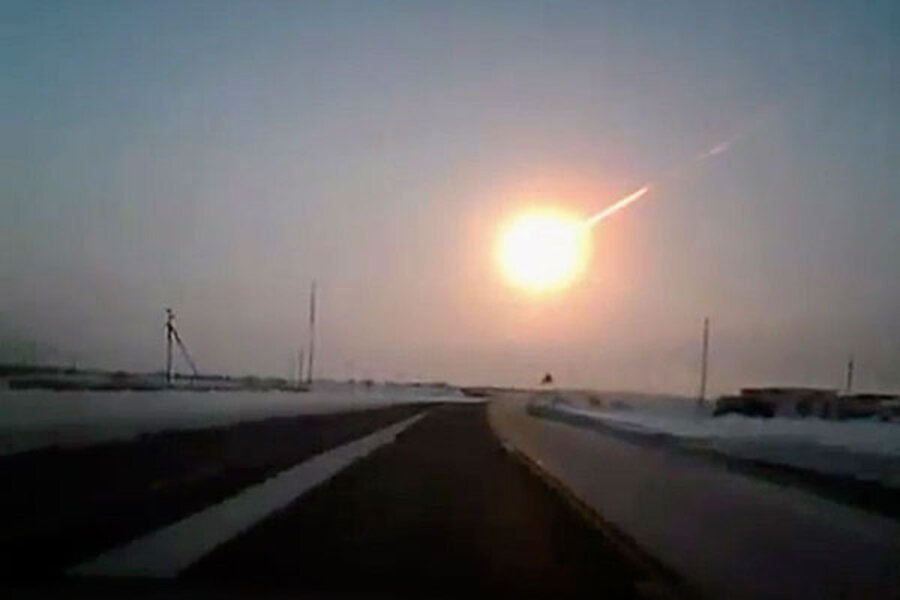Where did that Russian meteor come from? Astronomers determine origins.
Loading...
Just a week after a huge fireball streaked across the skies of the Chelyabinsk region of Russia, astronomers published a paper that reconstructs the orbit and determines the origins of the space rock that exploded about 14-20 km (8-12.5 miles) above Earth’s surface, producing a shockwave that damaged buildings and broke windows.
Researchers Jorge Zuluaga and Ignacio Ferrin at the University of Antioquia in Medellin, Colombia used a resource not always available in meteorite falls: the numerous dashboard and security cameras that captured the huge fireball. Using the trajectories shown in videos posted on YouTube, the researchers were able to calculate the trajectory of the meteorite as it fell to Earth and use it to reconstruct the orbit in space of the meteoroid before its violent encounter with our planet.
The results are preliminary, Zuluaga told Universe Today, and they are already working on getting more precise results. “We are working hard to produce an updated and more precise reconstruction of the orbit using different pieces of evidence,” he said via email.
But through their calculations, Zuluaga and Ferrin determined the rock originated from the Apollo class of asteroids.
Using triangulation, the researchers used two videos specifically: one from a camera located in the Revolutionary Square in Chelyabinsk and one video recorded in the a nearby city of Korkino, along with the location of a hole in the ice in Lake Chebarkul, 70km west of Chelyabinsk. The hole is thought to have come from the meteorite that fell on February 15.
Zuluaga and Ferrin were inspired to use the videos by Stefen Geens, who writes the Ogle Earth blog and who pointed out that the numerous dashcam and security videos may have gathered data about the trajectory and speed of the meteorite. He used this data and Google Earth to reconstruct the path of the rock as it entered the atmosphere and showed that it matched an image of the trajectory taken by the geostationary Meteosat-9 weather satellite.
But due to variations in time and date stamps on several of the videos — some which differed by several minutes — they decided to choose two videos from different locations that seemed to be the most reliable.
From triangulation, they were able to determine height, speed and position of the meteorite as it fell to Earth.
This video is a virtual exploration of the preliminary orbit computed by Zuluaga & Ferrin
But figuring out the meteroid’s orbit around the Sun was more difficult as well as less precise. They needed six critical parameters, all which they had to estimate from the data using Monte Carlo methods to “calculate the most probable orbital parameters and their dispersion,” they wrote in their paper. Most of the parameters are related to the “brightening point” – where the meteorite becomes bright enough to cast a noticeable shadow in the videos. This helped determine the meteorite’s height, elevation and azimuth at the brightening point as well as the longitude, latitude on the Earth’s surface below and also the velocity of the rock.
“According to our estimations, the Chelyabinski meteor started to brighten up when it was between 32 and 47 km up in the atmosphere,” the team wrote. “The velocity of the body predicted by our analysis was between 13 and 19 km/s (relative to the Earth) which encloses the preferred figure of 18 km/s assumed by other researchers.”
They then used software developed by the US Naval Observatory called NOVAS, the Naval Observatory Vector Astrometry to calculate the likely orbit. They concluded that the Chelyabinsk meteorite is from the Apollo asteroids, a well-known class of rocks that cross Earth’s orbit.
According to The Technology Review blog, astronomers have seen over 240 Apollo asteroids that are larger than 1 km but believe there must be more than 2,000 others that size.
However, astronomers also estimate there might be about 80 million out there that are about same size as the one that fell over Chelyabinsk: about 15 meters (50 feet) in diameter, with a weight of 7,000 metric tons.
In their ongoing calculations, the research team has decided to make future calculations not using Lake Chebarkul as one of their triangulation points.
“We are acquainted with the skepticism that the holes in the icesheet of the lake have been produced artificially,” Zuluaga told Universe Today via email. “However I have also read some reports indicating that pieces of the meteoroid have been found in the area. So, we are working hard to produce an updated and more precise reconstruction of the orbit using different pieces of evidence.”
Many have asked why this space rock was not detected before, and Zuluaga said determining why it was missed is one of the goals of their efforts.
“Regretfully knowing the family at which the asteroid belongs is not enough,” he said. “The question can only be answered having a very precise orbit we can integrate backwards at least 50 years. Once you have an orbit, that orbit can predict the precise position of the body in the sky and then we can look for archive images and see if the asteroid was overlooked. This is our next move!”
Read more about the Apollo class of asteroids here.
Nancy Atkinson is Universe Today's Senior Editor. She also is the host of the NASA Lunar Science Institute podcast and works with the Astronomy Cast and 365 Days of Astronomy podcasts. Nancy is also a NASA/JPL Solar System Ambassador.
Connect with Nancy on Facebook | Twitter | Google + | Website







